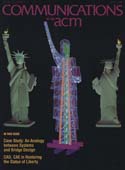April 1986 - Vol. 29 No. 4

Features
A computer science perspective of bridge design
What kinds of lessons does a classical engineering discipline like bridge design have for an emerging engineering discipline like computer systems design? Case-study editors Alfred Spector and David Gifford consider the insight and experience of bridge designer Gerard Fox to find out how strong the parallels are.
Computers, complexity, and the Statue of Liberty restoration
Twentieth-century techniques such as computer-aided engineering and finite-element analysis were used to restore the nineteenth-century monument.
Positive alternatives: a report on an ACM panel on hacking
A broad cross section of computer security experts, hackers, educators, journalists, and corporate executives examine hacking issues, problems, and possible solutions.
An empirical comparison of priority-queue and event-set implementations
Execution times for a variety of priority-queue implementations are compared under the hold model, showing many to be faster than implicit heaps.
Embedded menus: selecting items in context
In many situations, embedded menus represent an attractive alternative to the more traditional explicit menus, particularly in touchtext, spelling checkers, language-based program editors, and graphics-based systems.
A locally adaptive data compression scheme
A data compression scheme that exploits locality of reference, such as occurs when words are used frequently over short intervals and then fall into long periods of disuse, is described. The scheme is based on a simple heuristic for self-organizing sequential search and on variable-length encodings of integers. We prove that it never performs much worse than Huffman coding and can perform substantially better; experiments on real files show that its performance is usually quite close to that of Huffman coding. Our scheme has many implementation advantages: it is simple, allows fast encoding and decoding, and requires only one pass over the data to be compressed (static Huffman coding takes two passes).



